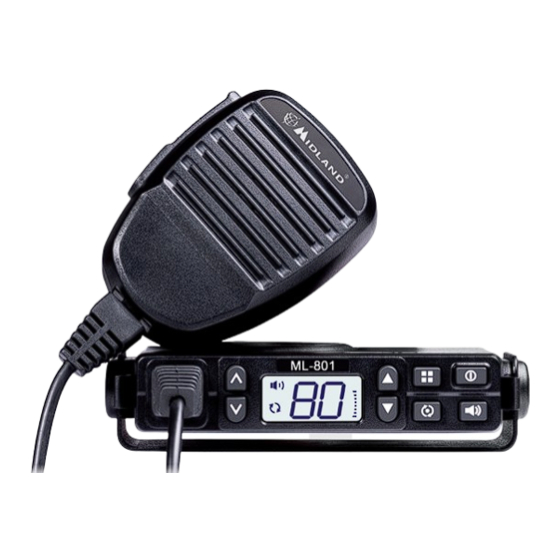
Table of Contents
Advertisement
Quick Links
Advertisement
Table of Contents

Summary of Contents for Midland ML801
-
Page 1: Instruction Manual
Instruction Manual C B M O B I L E Mini Compact Size. -
Page 2: Table Of Contents
CONTENTS Specifications..............................02 Introduction..............................03 What’s Included............................04 Emergency/Telecommand Channels......................04 Features................................05 General Operation............................06 Appendix: Frequency/CTCSS/DCS List....................14 Warranty.................................16 SPECIFICATIONS Output Power: 5 Watts CB Channels - RX/TX: CB Frequency Range: 476.425 ~ 477.4125MHz Channel Width: 12.5kHz (narrowband) Power Source (nominal): 13.8V Max Absorption Current in TX: 1.3A... -
Page 3: Introduction
Please read this manual carefully to understand its functions and operations. The ML801 you purchased is an advanced UHF in-vehicle two way radio. ML801 combines the very latest in electronic hardware with the most up-to date computer aided design and manufacturing techniques to produce an extremely compact mobile radio with outstanding specifications and performance. -
Page 4: What's Included
ACMA has reserved Channel 22 and Channel 23 as telecommand channels. Transmission is prohibited on these channels. ML801 blocks transmission on these 2 channels. Channels 61, 62 and 63 are for future use and TX is inhibited on these channels. -
Page 5: Features
FEATURES Microprocessor Controlled Frequency Synthesiser Allows user programmable control of scanning, channel memories and selected options. Scanning Function Quickly finds radio channels. Individually Programmable DUPLEX Function Selectable only for individual channels in areas that have a repeater. This leaves others free for use as simplex channels. -
Page 6: General Operation
7. Transmit Unique Flip Feature ML801 has a unique Display Flip function that allows the unit to be installed upside down if required. The display can be read in either orientation. When radio is off, press DOWN and POWER buttons to turn on the radio. The LCD display will flip by 180°. - Page 7 When the transmission ends the channel becomes quiet again. Transmissions that do not use the correct tone will not to be heard. There are two tone sets installed in your ML801 comprising 50 CTCSS and 104 DCS user-selectable tones.
- Page 8 CTCSS or DCS tones you will need to select the tone that matches theirs. The ML801 includes most of the commonly used tone sets. If the users you talk to don’t currently use CTCSS or DCS, choose your own tones.
- Page 9 CTCSS/DCS Once a DCS or CTCSS code is selected, your radio will now be in “Silent” mode on that channel and will remain muted in that channel unless a signal containing your selected CTCC/DCS tone is received. Channels that do not have CTCSS/DCS enabled will remain open to all signals. You may activate CTCSS/DCS on as many channels as you wish except channel 5 which is designated for emergency use.
- Page 10 Squelch control is used to eliminate the background noise when there are no signals present. The ML801 features a preset Squelch system. The Squelch sensitivity has been factory set to provide optimum performance in most environments. The sensitivity can be altered by the user if required to suit varying environmental situations.
- Page 11 Note: Channel 1-8 displays “r1-r8” after setting Duplex. Channel 41-48 displays “1r-8r” after setting duplex. Widen Frequency for Receiving If users need wider receiving frequencies, these can be added by an authorised Midland Dealer. Note: The widened frequency is only for receiving use. Adjusting the beep tone level The beep tone is designed to provide audible feedback whenever a key is pressed.
- Page 12 Scanning ML801 has a SCAN function that allows a selection of user programmable channels to be scanned for signals. Channels are scanned at 20 channels per second. When a signal is found, scanning will pause on that channel to allow the signal to be heard. Scanning will resume when the channel is clear again.
- Page 13 Using scan If a busy channel is found, scanning will pause on that channel to allow the signal to be heard and will remain there for as long as the channel is busy. Once the channel has been clear for 5 seconds, scanning will automatically resume.
-
Page 14: Appendix: Frequency/Ctcss/Dcs List
Appendix: Appendix: Two way radio frequency list Two way radio frequency list Simplex Mode Duplex Mode Simplex Mode Simplex Mode Duplex Mode Simplex Mode Appendix: Two way radio frequency list Frequency (MHz) Frequency (MHz) Frequency (MHz) Frequency (MHz) Frequency (MHz) Frequency (MHz) 01 476.4250 477.1750 (CH31) - Page 15 104 groups of DCS Frequencies 104 groups of DCS frequencies 104 groups of DCS Frequencies Dismantling and assembly drawings Dismantling and assembly drawings Dismantling and assembly drawings (A) The whole chart (A) The whole chart (A) The whole chart (B) Bracket assembly diagram (B) Bracket assembly diagram (B) Bracket assembly diagram Fixed bracket with 3 3 * 8 self tapping screws...
-
Page 16: Warranty
Please complete details below in the event of warranty service being required. Purchaser’s Name: Purchaser’s Address: ML801 Serial Number: Model Number: Date of Purchase:...














Need help?
Do you have a question about the ML801 and is the answer not in the manual?
Questions and answers